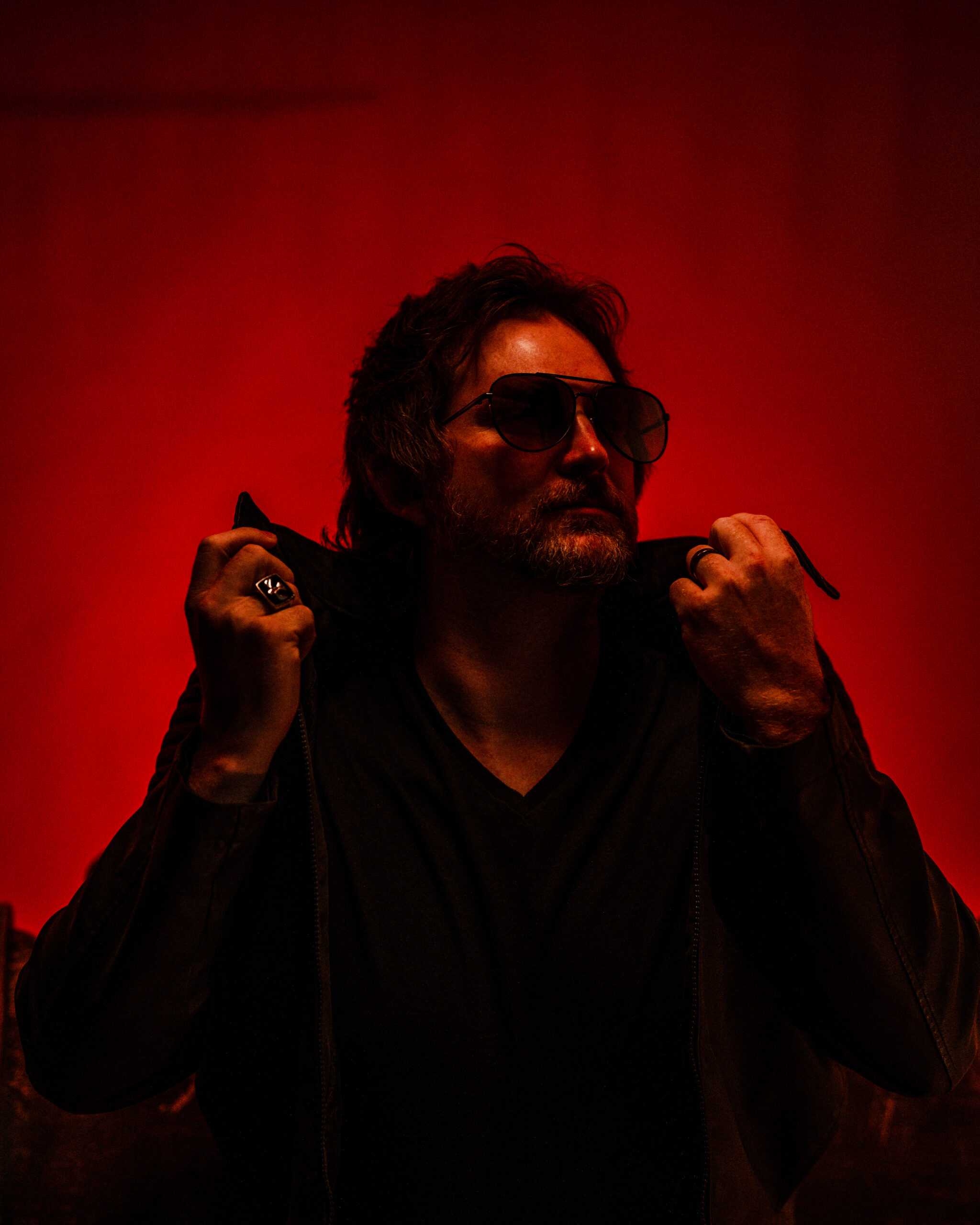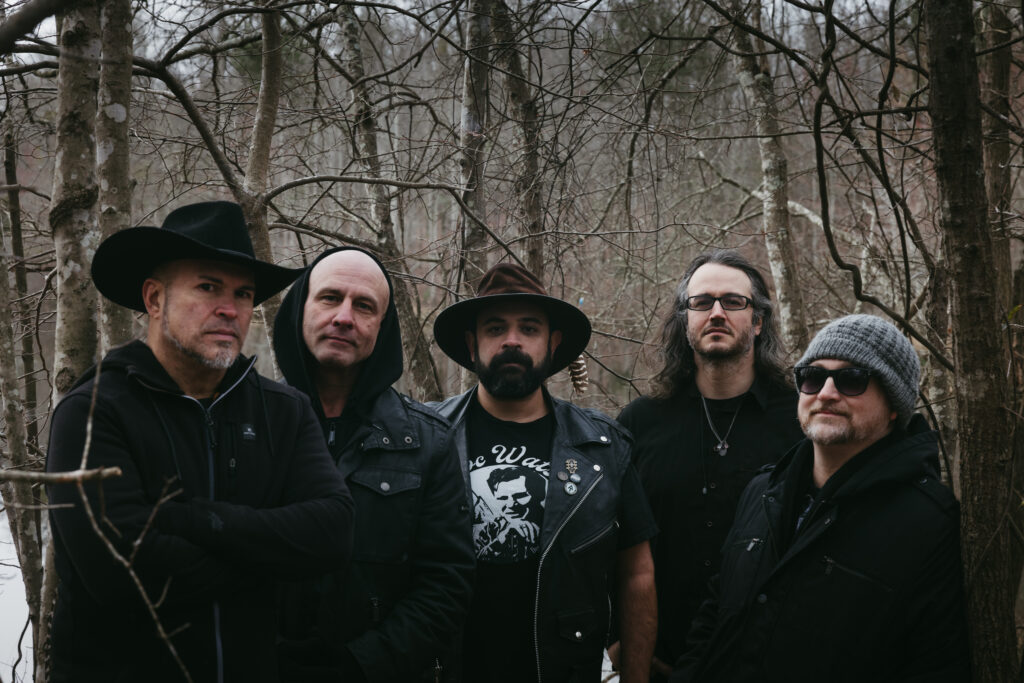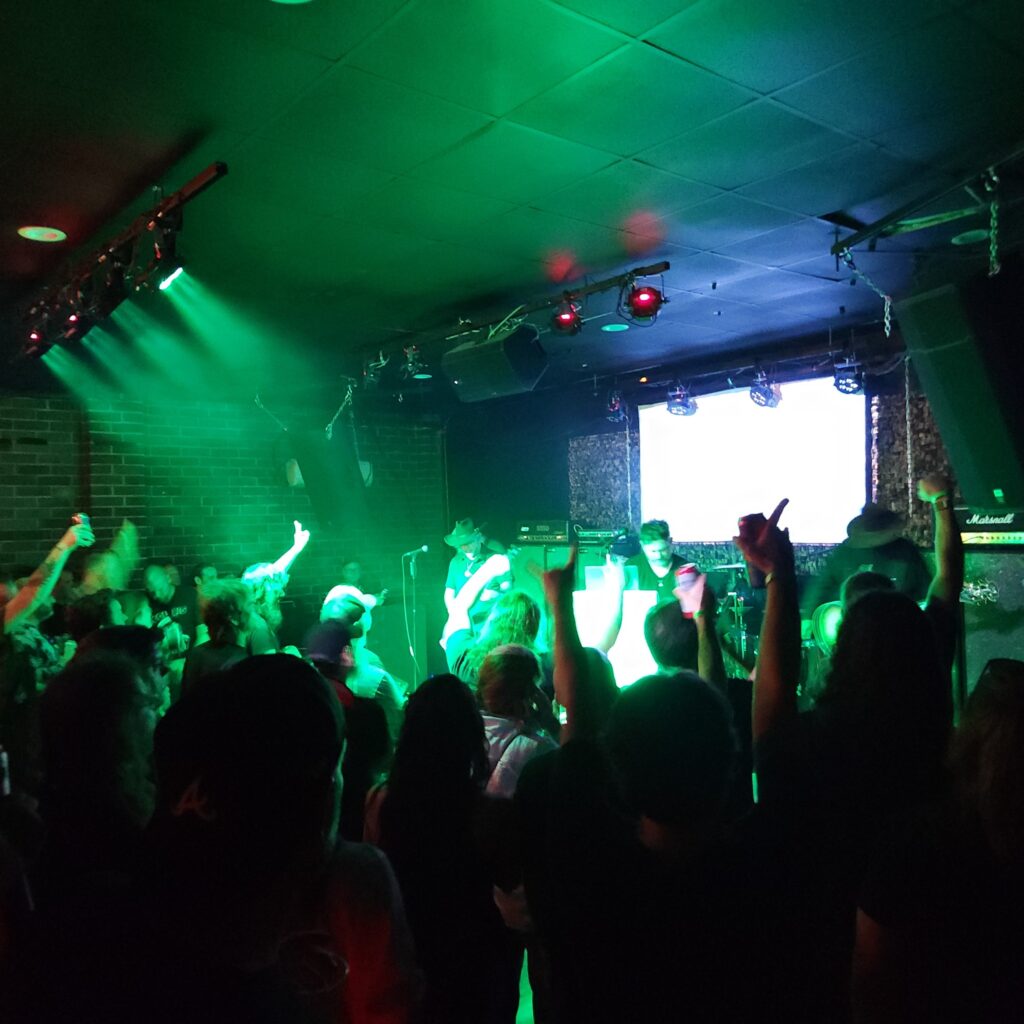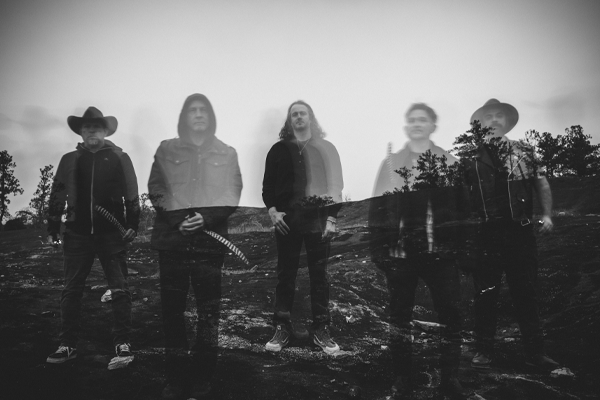Conducted by David Sherman | July 18th, 2024
A campfire will always have smoke. Obscuring the woods behind it, and occasionally blurring your vision when the smoke gets in your eyes. Insomniac is like that smoke – you understand what’s happening, but that understanding is obfuscated by the hypnotic and wave-like layers.
Over the past six years of their existence the members of Insomniac have worked with a shamanic approach to perfecting their psychedelia, both in their music but in the live show presented to their attendees. The result is an entrancing and willfully disorienting blend of desert rock and 60’s psych rock brought to the modern day with modern aesthetics.
A Rippin connected with vocalist Van Bassman to discuss the project, their upcoming tour, and beyond.

DS: How’d you get involved with Insomniac?
VB: Prior to joining Insomniac, Ben (The Buzzards of Fuzz / Gas Hound) and I went to the village to catch one their set and we were just blown away. At the time Jamie Smith (Bleach Garden, Canopy) was on bass and Sten (Turn Cold, Dropout) was still singing for them.
It was such a cool set. The whole time Ben and I kept turning to one another like, “Holy shit, holy shit this is amazing!”, they were building suspense in this fantastic way where one song ran into the next, and by the time the set ended your mind was just blown. You just had no idea what you just saw. I walked away thinking “Hey, that was incredible, I really love this band.”
I saw them a few more times, and then when Sten left the band while they were in the middle of recording with Josh Lamar (Mondo Generator, John Denver Death Plane). That became the guide for what we did later.
I really enjoyed Sten’s vocals and one of the things coming into this was that our style and approach were so different, that I was slightly concerned people would be taken aback. His vocals were a little more edgy, and screaming, whereas my approach was a little more melodic and layered.
So, there was a concern early on that people who were already a fan of it would not be into my version of Insomniac. An “Ozzy/Dio” situation. (laughs)
DS: So, was that your own concern, or was that a concern in the band?
VB: I don’t think anyone else in the band had that in mind – that was just for me.
Coming into something where you’re taking someone else’s vision – and these guys had an absolute vision – I wanted to make sure I honored what they built while adding my own flavor.
I spent the pandemic singing over the demos that they did with Josh. I would go downstairs every night and layer more and more vocals, and I’d send these tracks over to the guys who weren’t rehearsing obviously since everybody was on lockdown. They’d come back with notes, or this and that, because they had a story – the album itself is a concept album – and they had a story all ready to go. My challenge was to use their story to write these lyircs that fit the songs that they had already written.
Though it’s quite different sonically, I often compare it to Pearl Jam’s Ten. Jack Irons passed the Mookie Blaylock / Pearl Jam demo tape to Eddie Vedder, and he sang what became “Ten” over what was already recorded. Which is impressive if you think about it – it’s a challenge. Especially in the guidelines that you have to tell a certain story, and it needs to fit with something we’ve already done. And they were cool with adjusting what they had, but I wanted that challenge.
DS: Is the recording you were working with, and layering your vocals to – those were the recordings they made with Josh, or were these demos?
VB: Those were the recordings that they made with Josh; as far as I know they hadn’t added vocals,mixing or layering instruments, so It was a demo situation, but it was a nice demo.
DS: What were the considerations they were taking on with trying to adjust the music to what you did?
VB: In the end? None at all. I worked within the parameters I was handed. They did offer several times to adjust things but I wanted to preserve what they’d created.
We did record the full record with an additional song with Kristofer Sampson at Samson Sound. I found it more interesting to adapt to what they’d already done and didn’t really see a ton of value in changing what they’d already made, because it was so good.
I was a fan before I started singing for them. I didn’t want to step on any toes, I wanted to come in and be the fifth voice.
DS: Do you remember what it was that you made the commitment to them that you’d be the vocalist?
VB: It was right before the pandemic hit. After Sten left, they were looking for a vocalist, and Amos (Rifkin) mentioned “I’m looking” and we were discussing people who might be a good fit. I threw my hat into the ring as hard as possible. I felt like I would be great for this – I really enjoy the music and I think the concept is super rad, and I’d like to give it a shot.
We started with a couple of rehearsals. I brought in a keyboard to find the notes and figure out what they were doing. And then everything fell out with the pandemic, and none of us could meet up or do anything.
I’d say it was probably six weeks in I thought “let me make some noise”. I started going downstairs nightly and working in my home studio to demo vocals over it and I’d send demos them and it felt so strange these parts I was doing were so out there and odd and I was half sure that they’d come back and say “I don’t know man, that’s a little weird” but what I got was people saying, “How did you know? You nailed it. This was exactly what we wanted, and we didn’t know we wanted it”.
That was a really good feeling. There were minimal notes that came back, and when we got into the studio, and we were – Kris helped produce my vocals. He sat down with me line by line and we worked stuff out, but the main idea was kind of developed just there in the pandemic in those nights, just sending them what I thought would work and chasing it from there.
DS: How long was it between Sten leaving the band and you joining?
VB: I’m not sure. I think they were certainly very proud of what they were doing. I think Jamie, who was the original bassist, exited at about the same time. They had to rebuild the whole project. Juan Garcia, who is the bass player now, was in Brass Knuckle Surfers with Mike Morris, who is the other guitar player for Insomniac, so they had a year’s long, long relationship performing together. He suggested Juan who came in and nailed everything, he’s an absolute pro and the sweetest dude. That was where I came in right after Juan.
The band had reformed. I know there was a chunk of time between that moment and when we stepped foot on stage, because we took all this time to think about how things would work and then go to studio and really hammer it out, and then work on it to death to make sure what we’re doing live. There’s a large visual component to our performances and all of that just took a lot of thought and it was a lot to orchestrate for any live show. And once we got there it was like, “Ok, this is it.”
DS: Is there one person who has been driving the creation, from the instrumentalist aspect?

VB: I’d say Amos and Al, they kind of workshop everything together. Amos has a lot of really good ideas – I’ve never seen a drummer be so proactive in writing. Between the two of them, it’s kind of their baby. Mike adds these amazing textures to these songs, both vocally and instrumentally. His guitar playing is one of those things where I feel it before I notice it. There are still times today where I’ll be like, “Ah, that’s where that’s coming from. Wow, that’s not just a weird sound in my head!” It really made interesting parts to sing with, because there’s a lot of “Do I go with him here, do I go against him? Do I leave space for him?” There was a lot of thought that went into that.
DS: Was there a benefit to taking your time with the material, or do you feel like it came to you all at once?
VB: It definitely didn’t come to me all at once. And I had been trying to get there for a few months before things shut down. When shows stopped, it felt like there wasn’t a reason to make music. I started baking pies and making bread, and roller blading and all the things we all did. And then I obviously came back to the driver of why I make music. There’s a calling I can’t ignore. So, I just started going down there, and I think it was very freeing to be like, “I don’t have to sell this thing. I don’t need people to tell me this is good. I don’t have to go on stage and present this to anybody. What I feel compelled to do is complete this assignment. There’s a very big challenge, and I’m going to take my time with it.”
So became a mission in a time when there was no driver to do more. There was no reason to finish a record or write more songs. Except to put some positivity back in my world. I want this music to exist, and I want to tell the story.
The story came from them. They had this entire story from start to finish that I don’t want to ruin but, it’s a very intricate journey, it’s very interesting, and having all of that in place before I sang word one or wrote a single line… not only do you have the parameters of the music itself, but you have to tell the story. And there are certain parts of the story where “this instrumental is meant to mimic this” or “you’re on a mountain and snow is going by, that’s what this sound is”. It’s that level of detail. So, you had to not only write these lyrics to fit the music, but they also had to place where those parts of the story are happening. It was a lot, you know? It wasn’t something you could do quickly, so having that time off, and having only the desire for it to exist to push it brought me back to when I was a kid and I played guitar until my fingers bled because I was compelled. I needed to achieve whatever was around the corner. I needed to climb up and see what was at the top of the mountain. And I hadn’t had that in a bit, you know as musicians we sometimes get locked into playing the same 10 songs for a few years, and then you have to work that muscle to create what’s next. That was really revitalizing for me. It woke me up. Hey, make more. It doesn’t matter who’s listening, just make more because you want it to be there. I think that’s the most important thing we can do.
DS: And from your completing the assignment, finishing this body of work, what were the next steps as far as next steps?
VB: Once we were all starting to get vaccinated and could go back out, we started doing soft rehearsals, and that was the first time I got to do it with them. It took some kind of – it’s one thing when you’re in the studio and you can take twenty passes at a line and you’re just trying to figure it out – and then actually implementing the lyrics and saying “Ok, this works, or it doesn’t”. I didn’t change a ton, between what I did in the studio or not, because they play it correctly every time. They are a machine.
So, it was easy to translate what I was doing back to a live setting except that I was covering a lot of territory on the recordings. There were a lot of low parts, a lot of very high parts that I was doing, a lot of textures between them, so I might have seven layers on one vocal part, on one verse and then it’s like, what do I sing live? That’s when I started playing with those pedals and using different effects on my voice to mimic what my vision was in the studio.
Once we got comfortable with that, we hit up Kris Sampson, I’ve worked with him for years in Buzzards and he’s a phenomenal engineer and friend. I knew he’d get it. He’s just one of those people who’s always a step ahead of you. If you’re thinking of something he’s probably there. And he’s always got great ideas, and he’s also really easy to deal with. If you’re like, “Hey, I’m not really going for that he’s like ‘Cool, let’s try this.” There’s no it has to be this way because I’m twisting the knobs.
So, we did that, and we got the record done and are currently shopping it to labels. The next step was to begin performing live again.
Al (Avedissian) said it had been 5 years since Insomniac had been on stage. Let’s take the stage and figure out how to present this visually. It’s a concept, there’s a story there.
Al is a wanderer, he is constantly climbing mountains, it sounds like I’m exaggerating but I’m not. He’s always in nature, and a lot of this story revolves around a journey through nature.
He grabbed clips while he was in these different places all over the world, video of the journey. I am a roller coaster enthusiast and I too was grabbing clips of rollercoasters and dark rides, my journey. Things that I thought fit in with the story. Those rides take you to some amazing places if you let them.
We integrated these videos together with some B-movie footage to tell a story. This is incorporated with 3d mapping to present a projected story that’s part regular film part psychedelic vision that lives only in that moment. It’s never the same twice.
It messes with your perception. It’s not your direct focus, but neither are we. This band is meant to have no egos, it’s the death of the ego. It’s meant to be a journey, it’s a trip. So my job is not to be some David Lee Roth style frontman “Look at me I’m Van I’m singing”, my job is to be present and narrate this journey with the room. You might see some stray lines out to the side, some little floaters in your eye and you don’t know what they are.
DS: So that’s purposeful having the visual stimuli.
VB: We’re all of a mind that this music is not just about what you’re hearing. There are other senses available. We’ve got incense going, visually there are a lot of things going on, and we’re already impacting the aural senses. I think what we have musically is very strong, and if you put on this record, you’re going to enjoy it. But when you’re presenting something like this it’s smart to impact every sense that you can.
DS: So, what you’re saying, you work on the material, you guys record, you basically are recording and figuring out how to replicate what you’ve written for a live setting. You have the projection and the mapping projection. You played your first show. Now we’re in the go-forward phase of the story. You have the product, you guys are practicing, you have an album that is finished that you’re shopping around. What has the past year been like, and what are the plans for the upcoming tour?
VB: I think we played three dates in town between the July show and now. Those were different presentations of the same information. Sometimes time constraints mean we can’t play the full set, which means the video changes which means the story changes. So, we’ve been learning to adapt that. Now I feel like we’re ready. This tour is ten dates, it’s our first journey out there together, and we’re all very much looking forward to it. It’s in support of the amazing Vanishing Kids, and I can’t’ recommend them enough. Just talk about amazing textured layers.
I think that what’s interesting is that neither of us have a genre to call home. We both get lumped into heavy psych, but that’s really pretty wide net at this point and nobody seems to be doing what we’re doing. Hearing Vanishing Kids, they’re not exactly what we’re doing, we’re cousins not sisters but I think it will be an incredible fit. It’s going to map out and pair well. And we’re playing with some heavy hitters o dates like Wailin Storms, Friendship Commanders, Heavy Temple, Valley of the Sun etc. It’s going to be a good time every night. I think we lucked out with this run, and I’m hoping that we get in front of the right ears, and they get what we’re trying to present. It’s not what everybody does, but I think that’s the point of music.

Insomniac begins their tour July 18th in Indianapolis, IN. They play Boggs Social and Supply in Atlanta on July 25th. At all shows they will be taking preordes for a tour exclusive lathe cut vinyl 7″.
7.18 @blackcircleindy / Indianapolis, IN
7.19 @portal_louisville / Louisville, KY
7.20 @foundrylakewood / Lakewood, OH
7.21 @metro_baltimore / Baltimore, MD
7.22 @thekingslandpresents / Brooklyn, NY
7.23 @thecobracabanarva / Richmond, VA
7.24 @theoddavl / Asheville, NC
7.25 @boggssocial / Atlanta, GA
7.26 @drkmttrcollective / Nashville, TN
7.27 @reggieslive / Chicago, IL
Tour info at tickets for all shows are available online at Insomniacvibes.com

